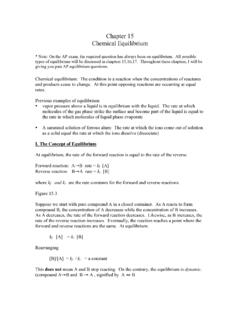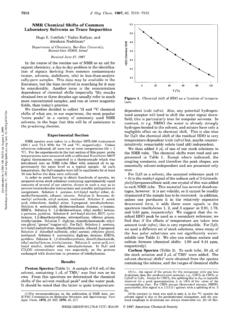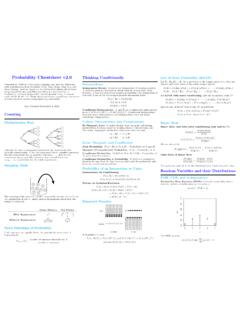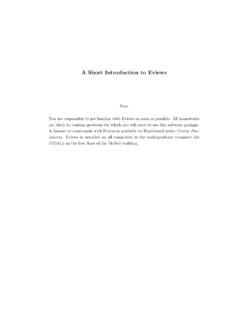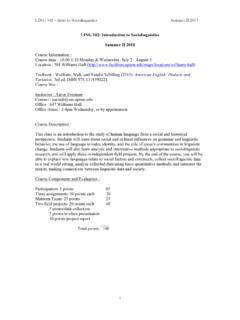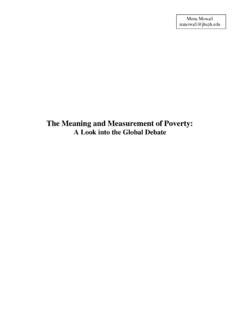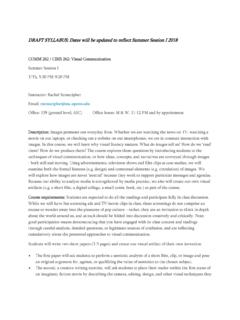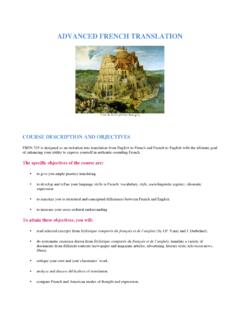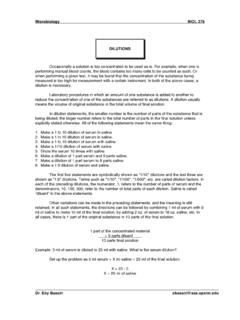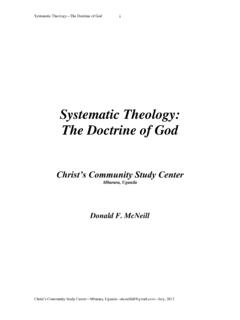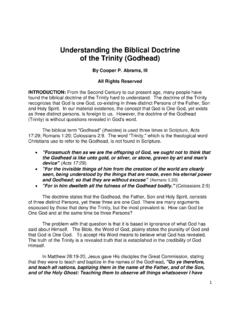Transcription of What Did Ham Do to Noah? - University of Pennsylvania ...
1 1 [The following essay was published in The Words of a Wise Man s Mouth are Gracious (Qoh 10,12), Festschrift Gunter Stemberger, ed. Mauro Perani (Walter de Gruyter: Berlin, 2005), pp. 257-265. The book is available at The essay appears here substantially as published but with some additions indicated in this color.] What Did Ham Do to Noah? by DAVID M. GOLDENBERG The biblical story of Noah s drunkenness and curse of Canaan (Gen 9:20-29) remains problematic. The three core difficulties are: why was Noah s curse one of slavery; why was the curse pronounced against Canaan, when it was his father, Ham, who committed the crime against Noah; and what was it that Ham did to Noah?
2 1 Even the discoveries of the Ugaritic myths have not much helped in solving these problems. The parallels to the story of the drunken El and his three sons, Thukamuna ( kmn), Shunama ( nm) and Haby ( by), may indicate a shared literary or other background at some point, but the parallels are too general to help us elucidate the Noah story in its particulars, or to shed light on the names of Noah s sons, Shem, Ham, and Similarly unhelpful have been other efforts of explanation based 1 These and other problems in the biblical story and the various proposed solutions are reviewed lately by BRICHTO, The Names of God.
3 Poetic Readings in Biblical Beginnings (New York/Oxford, 1998), 167-176; see also the opening pages of ROBERTSON, Current Critical Questions concerning the Curse of Ham (Gen 9:20-27), Journal of the Evangelical Theological Society (1998) 177-188. 2 While the first two dutiful sons support their drunken father, Haby berates him. The Ugaritic text has been most recently translated by T. LEWIS in Ugaritic Narrative Poetry, ed. PARKER ([Atlanta], 1997), 194, whose interpretation berates I have adopted. The basic meaning of the Ugaritic ng is to pursue (Gregorio del Olmo Lete and Joaqu n Sanmart n, translated by Wilfred Watson, A Dictionary of the Ugaritic Language, Leiden, 2003, 2:623) or oppress (David Clines, Dictionary of Classical Hebrew, Sheffield, 1993, 5:614, ng ).
4 Bibliography on the text may be found in B. MARGALIT, The Ugaritic Feast of the Drunken Gods: Another Look at RS (KTU ), Maarav (1979-80) 65-66, nn. 1-2. For a discussion of the possible relationship between the biblical story and the Ugaritic myth, see M. GARSIEL, Parallels between the Book of Jeremiah and the Book of Psalms (Ph. D. diss., Tel Aviv Univ., 1973) 1:100, and idem, Biblical Names: A Literary Study of Midrashic Derivations and Puns (Ramat Gan, 1991), 139-140. See also S. LOEWENSTAMM, En iqlopedya Miqra<it (Jerusalem, 1950-88) 3:163, m, and K.
5 VAN DER TOORN, Family Religion in Babylonia, Syria and Israel (Leiden, 1996), 154-155. On the origin of the names kmn and nm, see D. PARDEE, UKAMUNA WA UNAMA, Ugarit Forschungen 20 (1988) 195-199; Dictionary of Deities and Demons in the Bible, ed. K. VAN DER TOORN, B. BECKING, P. W. VAN DER 2 on Greek myths of a universal flood and the repopulation of the earth from Iapetus, one of the The rabbinic explanations of the story also present us with enigmatic elements. The Babylonian Talmud (San 70a) records a debate between two third-century sages, Rav and Samuel, regarding the act that Ham committed against his father ( Noah awoke from the effects of the wine and knew what his youngest son had done to him ; beyond this the Bible is silent).
6 Rav said that Ham castrated his father, Noah; Samuel said that he sodomized him. On what basis did Rav and Samuel come to these conclusions? Certainly the curse of slavery is a severe punishment and demands a correspondingly severe crime, but why specifically castration and sodomy? In a (somewhat) different age, these rabbinic interpretations were derisively dismissed by Raoul Allier, then Dean of the Facult libre de th ologie protestante of Paris, as HORST (Leiden, 21999), thykamuna, shunama, haby.
7 It was considered obligatory in Ugaritic culture for a son to care for his drunken father. See KTU i 30-31 (Aqhat) (M DIETRICH, O. LORETZ, J. SANMART N, The Cuneiform Alphabetic Texts, M nster, 1995, 48; Ugaritic Narrative Poetry, 53; GIBSON, Canaanite Myths and Legends,Edinburgh, 1977, p. 104, lines 31-32), which lays out the main responsibilities of a son toward his aged father among which are that he take him by the hand in his drunkenness, and support him when he is sated with wine. As VAN DER TOORN remarks, these filial duties are projected upon the world of the gods in the El myth (VAN DER TOORN, ibid.)
8 , whose translation of Aqhat I follow). According to BENO JACOB respect for the father is the theme of the story of Noah s drunkenness (B. JACOB, The First Book of the Bible: Genesis, abridged, edited and translated by JACOB and W. JACOB, New York, 1974, p. 68 to Gen 9:28). Another attempt to explain the story against the background of the ancient Near Eastern context (curses threatening a position of authority) was made by S. GEVIRTZ, Curse Motifs in the old testament and the Ancient Near East ( diss. University of Chicago, 1959), 147-148.
9 3 Pindar, Olympian Odes The name Iapetus yields no plausible Greek etymology, and it is far from unlikely that it is to be connected with that of Japhet son of Noah, both probably going back to some very old figure of Asianic mythology, variously handled by Greek and Hebrew tradtion ( ROSE in Oxford Classical Dictionary, ed. HAMMOND and SCULLARD, Oxford, 21970, Iapetos; see also Dictionary of Deities, 462-63). Similarly, BASTOMSKY argues for a connection between the biblical and Greek stories ( Noah, Italy, Sea-Peoples, JQR 67 [1976-77] 148, n.)
10 7 and 152), as do A. VAN SELMS, Judge Shamgar, VT 14 (1964) 308, and DAVID NEIMAN The Two Genealogies of Japhet, in Orient and Occident. FS Cyrus Gordon, AOAT 22, ed. Hoffner (Neukirchen-Vluyn, 1973), p. 123; cf. S. SCHIPPER in the German Encyclopaedia Judaica (Berlin, 1928) 8:753-754, Jafet, and LOWENSTAMM in En iqlopedya Miqra<it 3:746, yefet . The account in the Sibylline Oracles ( old testament Pseudepigrapha, ed. J. CHARLESWORTH, Garden City NY, 1983, 1:364-365), dated to the mid-second century BCE, may be a echo of the same shared tradition, or it may be an attempt to accommodate the Greek story of three sons of Gaia and Ouranos (Iapetos, Kronos, Titan) to the biblical narrative of the Tower of Babel.
